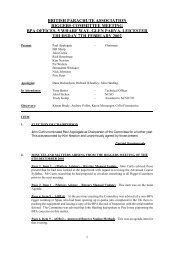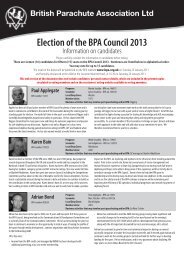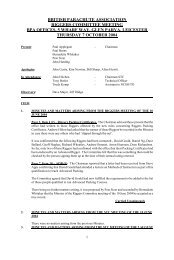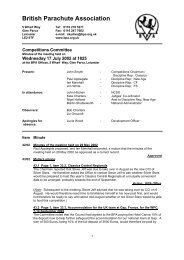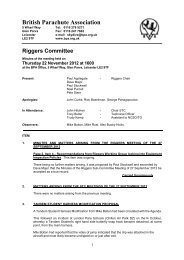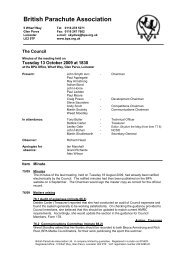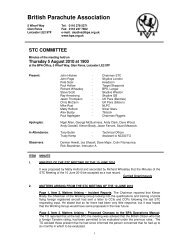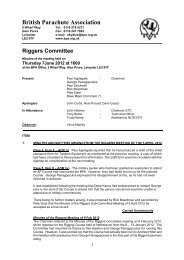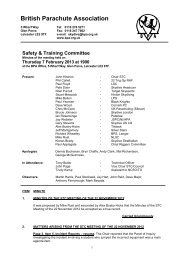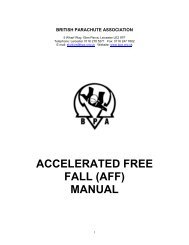Formation Skydiving Progression Manual - British Parachute ...
Formation Skydiving Progression Manual - British Parachute ...
Formation Skydiving Progression Manual - British Parachute ...
You also want an ePaper? Increase the reach of your titles
YUMPU automatically turns print PDFs into web optimized ePapers that Google loves.
We also mentioned body position as a factor in achieving a good track. We do everything we<br />
can with our torso to achieve lift by rolling the shoulders, sucking in the abdomen.<br />
Mastering a good track position requires a good understanding of what you are trying to achieve<br />
and having a well rehearsed routine and checklist.<br />
When learning to track, an example of a routine we can use is known as the seven-stage track.<br />
When learning it, it will take approximately seven seconds to get into the optimum tracking<br />
position before deployment and it is not recommended to attempt the seven-stage method if you<br />
intend to start if below a height of 5000ft. However, it can be practised on a tracking dive initially,<br />
and then used as the method at the end of each skydive for separation once proficient.<br />
The Seven-stage Track<br />
1. Slow Fall and Turn<br />
Since the idea is to create as much lift and air pressure as possible, start to build up air<br />
pressure by adopting a slower fall rate position as you turn 180 degrees into your clear air<br />
space. De-arch! (Even consider stretching arms out forwards as per your slow fall<br />
position to assist in creating lift)<br />
2. Legs<br />
When you are facing your clear airspace extend your legs fully for maximum air<br />
deflection, legs straight, point toes, press shins on the relative air.<br />
3. Arms<br />
As you start to move, sweep back your arms to either side of your torso in a slow and<br />
controlled way. Palms of hands down.<br />
4. Look Left and Right<br />
When tracking into clear airspace maintain observation, look for other trackers and - even<br />
worse – canopies.<br />
5. Look Above and Below<br />
As above.<br />
6. Flare<br />
When flaring, go back into slow fall position for maximum air deflection and drag.<br />
7. Pull<br />
Provided you tracked off at 5000ft and had no problems during the track, you should now<br />
be at about 3500ft.<br />
We have already mentioned that tracking is a survival skill. The aim of the FS1 progression is to<br />
teach you the skills necessary to perform 4-way formation skydiving and as the very nature of<br />
formation skydiving is to be able to skydive in bigger groups, the need to be able to track off into<br />
clear airspace becomes more apparent. If the skydive all goes to plan and enough time is allowed<br />
between groups on exit and at break off everyone turns 180 degrees away from the centre of a<br />
formation then finding a clear airspace is easy. However things don’t always go to plan and the<br />
ability to be able to change your heading, as an avoidance manoeuvre whilst tracking is vital.<br />
Whilst tracking, the most effective way to change your heading is to use your head. Your heading<br />
comes from being symmetrical and the keystone to this symmetry is the head. The head acts like<br />
a rudder but at the front instead of the back. If you are heading towards an unexpected obstacle,<br />
look at clear airspace and point your nose in the direction you want to go.<br />
23



